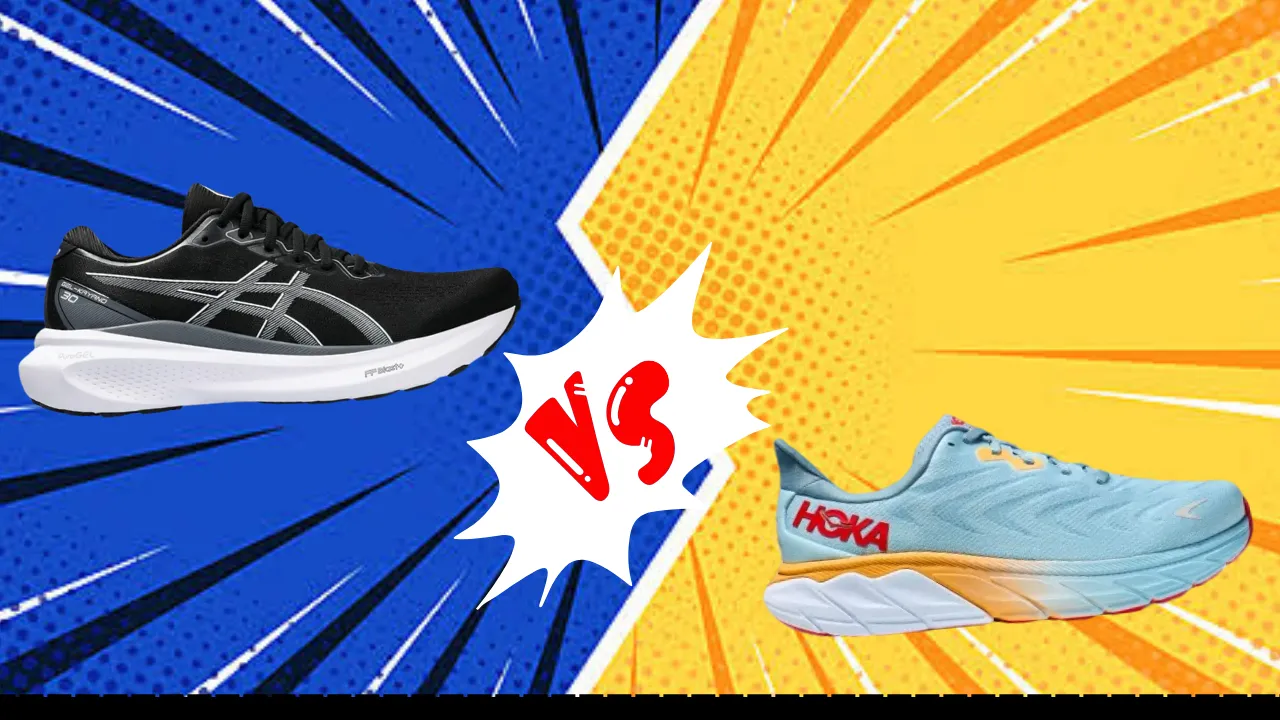The ASICS Kayano 30 and Hoka Arahi 6 are premium stability running shoes designed to provide support and comfort for overpronators and runners with flat feet.
In this in-depth comparison, we’ll highlight the key similarities and differences between these two popular models to help you determine which one may be the better choice for your running needs.
Similarities And Differences Between Asics Gel Kayano 30 and Hoka Arahi 6:
| Spec | ASICS Kayano 30 | Hoka Arahi 6 |
|---|---|---|
| Launched In | 2023 | 2022 |
| Stability | Dynamic DuoMax support system, Guidance Line technology | J-Frame technology, early stage meta-rocker geometry |
| Flexibility | Flex grooves in outsole | Flex grooves in outsole |
| Sizing | Men’s 7-13, Women’s 5.5-12 | Men’s 7-13, Women’s 5.5-12 |
| Weight | 10.6 oz (M), 9.7 oz (W) | 9.2 oz (M), 7.8 oz (W) |
| Cushion | Gel technology in heel/forefoot | CMEVA midsole |
| Outsole | AHAR+ rubber | Durabrasion rubber |
| Midsole | FlyteFoam Propel | J-Frame technology |
| Upper | Engineered mesh | Engineered mesh |
| Price | $160 | $140 |
Features Comparison
Materials
The Kayano 30 uses FlyteFoam Propel technology in the midsole which provides responsive cushioning. The outsole uses AHAR+ rubber for durability and traction. The engineered mesh upper provides breathability.
The Arahi 6 has a CMEVA midsole for cushioning and a durable rubber outsole. It also has an engineered mesh upper for breathability.
Durability
Both shoes are quite durable thanks to rubber outsoles and quality materials in the upper. The Kayano 30 may have a slight edge in longevity thanks to the AHAR+ rubber which is designed to be long-lasting.
Some testers noted the Arahi 6 may not last as many miles. Overall, both provide good durability for the premium stability shoe category.
Fit
The Kayano 30 and Arahi 6 have a wider toe box to accommodate wider feet. The Kayano 30 provides a more snug and tailored fit through the midfoot while the Arahi 6 runs slightly larger.


The Arahi 6 may work better for those needing more room. Both get high marks for comfort but the Kayano 30 may have a more dialed-in fit.
Stability
With features like the Dynamic DuoMax system and Guidance Line technology, the Kayano 30 provides excellent stability for overpronators. The Arahi 6 also delivers great stability through its J-Frame and meta-rocker geometry. Both control excess inward rolling but some testers felt the Kayano 30 was slightly more stable.
Cushioning
The Kayano 30 offers plush cushioning through Gel units in the rear and forefoot. The FlyteFoam Propel midsole is also very responsive. The Arahi 6 has a well-cushioned CMEVA foam midsole. Testers found both shoes provide excellent shock absorption and energy return during the gait cycle.
Value
These are premium shoes around the $160-140 price point. The Kayano 30 offers features like a gel cushioning system and specially engineered stability components that justify the price for needed support.
The Arahi 6 provides great stability and cushioning at a slightly lower cost. Overall, both deliver excellent support and comfort for the price.
Performance Comparison
Walking
The ample cushioning and stability features in both shoes make them a great choice for walking. The Kayano 30 provides a very smooth and comfortable walking stride while the Arahi 6 is quite lightweight with good responsiveness. For all-day wear while walking, the Kayano 30 may have the edge thanks to the gel cushioning system.
Running
As stable running shoes, both models shine for running. The Kayano 30 provides a stable yet smooth and propulsive ride. The Arahi 6 encourages an efficient gait cycle thanks to the meta-rocker geometry. For longer distances, the Kayano’s extra cushioning stands out but the Arahi is fantastic for faster paces.
Plantar Fasciitis
With good arch support and ample cushioning, both shoes can relieve plantar fasciitis pain. The Kayano 30 seems better suited to provide support and reduce overpronation which can aggravate the condition.
However, the Arahi 6 is lighter which some may prefer for the condition. Overall, the Kayano 30 wins out for its stability and plush cushioning.
Standing All Day
The Arahi 6’s lightweight build gives it an advantage for all-day standing comfort and fatigue reduction. However, the Kayano 30’s gel cushioning system and smooth supportive transitions are also great for extended wear. Overall, the Arahi 6 gets the edge for all-day wear due to its lighter weight.
Conclusion
For runners needing a well-cushioned stability shoe, both the ASICS Kayano 30 and the Hoka Arahi 6 are excellent options to consider. The Kayano 30 shines for its plush gel cushioning, smooth and stable stride, and dialed-in midfoot hold.
The Arahi 6 is a lighter-weight choice with great responsiveness, meta-rocker geometry for gait efficiency, and a roomier fit. For severe overpronators or those needing maximum stability, the Kayano 30 remains the top choice.
However, the Arahi 6 can also support many mild to moderate overpronators at a lower price. Weigh your specific running needs and preferences to decide which of these two great stability shoes is the better choice for you.



